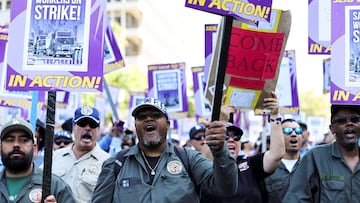Labor Day in US: origin, meaning and why is it celebrated today?
Labor Day will be celebrated in the United States on Monday, Sept. 2. What is the origin of the holiday?


Unlike most countries that celebrate International Workers Day on May 1, Labor Day in the United States this year falls on Monday, Sept. 2. While the country does not celebrate International Workers Day, the date was selected to commemorate the Haymarket affair, which took place in Chicago on May 4, 1886. The Haymarket affair began as a labor demonstration that ended after a bombing left four dead and over seventy injured. The event is seen as a pivotal moment in the American labor movement and influenced the government’s decision to limit the working day to eight hours.
Labor Day in the U.S. recognizes the American labor movement and the work and contribution of laborers to the development and achievements of the United States.
READ ALSO: Why Labor Day in the United States isn’t held in May
The labor movement started in the late 19th century and became an official federal holiday in 1894. This holiday symbolizes the end of summer for many Americans, and like any long weekend, it is celebrated with parties, parades, and all sorts of events.
How did it all start?
During the industrial revolution in the late 1800, workers around the world were forced to work 12 hours a day, seven days a week, to make ends meet. In the United States, many states had no laws to protect children, and many as young as five could work at mills, factories, and mines to earn a fraction of what adults made. Work conditions were unsafe, and there was no full access to fresh air, sanitary facilities, and breaks. As manufacturing work started to outgrow agriculture work, in the late 18th century, workers began organizing strikes and rallies to protest the poor work conditions, the long hours, and the number of days they worked.
Some workers, like those who worked for the railway tycoon George Pullman, had had enough after an economic crisis in 1893 uncovered for many the extent of their exploitation. Pullman had figured out that by creating towns around his factories where he owned all the firms and controlled all the pricing, he could keep wages low and pass the wages back to himself. When the economic crisis struck, Pullman increased the rents of the workers without increasing wages, leading to a historic labor disruption organized by Eugene Debs through the American Railway Union.
READ ALSO: Why you shouldn’t (or should!) wear white after Labor Day
The Pullman worker’s strike began on May 11, 1894, and shut down the railways between Chicago and the West Coast. President Glover Cleveland sent in federal troops to break up the strike, citing concerns over the timely delivery of mail. Many labor historians have tied Cleveland’s true intentions in stopping the strike to the protection of the interests of the capitalist class, including George Pullman, by keeping interstate commerce moving. When the troops arrived, they used highly repressive violence to suppress the strikers and get the trains back on schedule. During this federal intervention, more than seventy people were killed, and thousands were injured.
Related stories
After the events, many politicians sought to get labor back on their side by establishing a day for laborers to celebrate their efforts. The first labor day celebrated in the United States took place in September 1894 and has continued ever since.
Its continued existence is justified by the wealth of necessary action taken by workers to secure their livelihoods.


Complete your personal details to comment